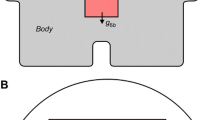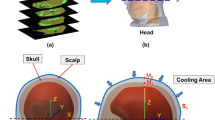Abstract
A three-dimensional model is developed in this study to examine the transient and steady state temperature distribution in the brain during selective brain cooling (SBC) and subsequent rewarming. Selective brain cooling is induced through either wearing a cooling helmet or packing the head with ice. The ischemic region of the brain is simulated through reducing the blood perfusion rate to 20% of its normal value. The geometric and thermal properties and physiological characteristics for each layer, as well as the arterial blood temperature, are used as the input to the Pennes bioheat equation. Our data suggest that rapid cooling of the brain gray matter can be achieved by SBC on the head surface (26 min for adults versus 15 min for infants). Suboptimal thermal contact between the head surface and the coolant in most commercially available cooling helmets is suspected to be the main reason for delayed cooling in SBC as compared to the ice packing. The study has also demonstrated that the simulated 3 °C/h passive rewarming rate by exposing the head to room temperature after removing the source of cooling may be too rapid. © 2003 Biomedical Engineering Society.
PAC2003: 8710+e, 8719La, 8719Pp, 8719Uv
Similar content being viewed by others
REFERENCES
Bernard, S. A., B. M. Jones, and M. Buist. Experience with prolonged induced hypothermia in severe head injury. Crit. Care3:167–172, 1999.
Busto, R., W. D. Dietrich, M. Y.-T. Globus, I. Valdes, P. Scheinberg, and M. D. Ginsberg. Small differences in intraichemic brain temperature critically determine the extent of ischemic neuronal injury. J. Cereb. Blood Flow Metab.7:729–738, 1987.
Clifton, G. L., E. R. Miller, S. C. Choi, H. S. Levin, S. McCauley, K. R. Smith, Jr., J. P. Muizelaar, F. C. Wagner, Jr., D. W. Marion, T. G. Luerssen, R. M. Chesnut, and M. Schwartz. Lack of effect of induction of hypothermia after acute brain injury. N. Engl. J. Med.344:556–563, 2001.
el Nasr, M. Deif, J. Nuglisch, and J. Krieglatein. Prevention of ischemia-induced hypothermia by controlling the environmental temperature. J. Pharmac. Meth.27:23–26, 1992.
Dietrich, W. D.The importance of brain temperature in cerebral injury. J. Neurotrauma9:s475–485, 1992.
Gal, R., I. Cundrle, I. Zimova, and M. Smrcka. Mild hypothermia therapy for patients with severe brain injury. Clinical Neurology and Neurosurgery104:318–321, 2002.
Gelman, B., C. L. Schleien, A. Lohe, and J. W. Kuluz. Selective brain cooling in infant piglets after cardiac arrest and resuscitation. Crit. Care Med.24:1009–1017, 1996.
Jiang, J. Y., M. Yu, and C. Zhu. Effect of long-term mild hypothermia therapy in patients with severe traumatic brain injury: 1-year follow-up review of 87 cases. J. Neurosurg.93:546–549, 2000.
Kolios, M. C., A. E. Worthington, M. D. Sherar, and J. W. Hunt. Experimental evaluation of two simple thermal models using transient temperature analysis. Phys. Med. Biol.43:3325–3340, 1998.
Krieger, D. W., M. A. De Georgia, A. Abou-Chebl, J. C. Andrefsky, C. A. Sila, I. L. Katzan, M. R. Mayberg, and A. J. Furlan. Cooling for acute ischemic brain damage (cool aid): An open pilot study of induced hypothermia in acute ischemic stroke. Stroke32:1847–1854, 2001.
Ku, Y., L. D. Montgomery, and B. Webbon. Hemodynamic and thermal responses to head and neck cooling in men and woman. Am. J. Phys. Med. Rehabil.75:443–450, 1996.
Kuhnen, G., R. Bauer, and B. Walter. Controlled brain hypothermia by extracorporeal carotid blood cooling at normothermic trunk temperatures in pigs. J. Neurosci. Methods89:167–174, 1999.
Maier, C., G. Sun, and D. Kunis. Delayed induction and long-term effects of mild hypothermia in a focal model of transient cerebral ischemia: neurologic outcome and infarct size. J. Neurosurg.94:90–96, 2001.
Marion, D. W., L. E. Penrod, S. F. Kelsey, W. D. Obrist, P. M. Kochanek, A. M. Palmer, S. R. Wisniewski, and S. T. DeKosky. Treatment of traumatic brain injury with moderate hypothermia. N. Engl. J. Med.336:540–546, 1997.
Marion, D. W., Y. Leonov, M. Ginsberg, L. M. Katz, P. M. Kochanek, A. Lechleuthner, E. M. Nemoto, W. Obrist, P. Safar, F. Sterz, S. A. Tisherman, R. J. White, F. Xiao, and H. Zar. Resuscitative hypothermia. Crit. Care Med.24:S81-S89, 1996.
Markgraf, C., G. Clifton, and M. Moody. Treatment window for hypothermia in brain injury. J. Neurosurg.95:979–983, 2001.
Minamisawa, H., P. Mellergard, M. L. Smith, F. Bengtsson, S. Theander, F. Boris-Moller, and B. K. Siesjo. Preservation of brain temperature during ischemia in rats. Stroke21:758–764, 1990.
Olsen, R. W., L. J. Hayes, E. H. Wissler, H. Nikaidoh, and R. C. Eberhart. Influence of hypothermia and circulatory arrest on cerebral temperature distributions. ASME J. Biomech. Eng.107:354–360, 1985.
Pennes, H. H.Analysis of tissue and arterial blood temperatures in the resting human forearm. J. Appl. Physiol.1:93–122, 1948.
Schwab, S., S. Schwarz, M. Spranger, E. Keller, M. Bertram, and W. Hacke. Moderate hypothermia in the treatment of patients with severe middle cerebral artery infarction. Stroke29:2461–2466, 1998.
Segawa, H.Tomographic cerebral blood flow measurement using xenon inhalation and serial CT scanning: Normal values and its validity. Neurosurg. Rev.8:27–33, 1985.
Shiozaki, T., H. Sugimoto, M. Taneda, H. Yoshida, A. Iwai, T. Yoshioka, and T. Sugimoto. Effect of mild hypothermia on uncontrollable intracranial hypertension after severe head injury. J. Neurosurg.79:363–368, 1993.
Soukup, J., A. Zauner, E. M. Doppenberg, M. Menzel, C. Gilman, H. F. Young, and R. Bullock. The importance of brain temperature in patients after severe head injury: Relationship to intracranial pressure, cerebral perfusion pressure, cerebral blood flow, and outcome. J. Neurotrauma.19:559–571, 2002.
Stone, J. G., W. L. Young, C. R. Smith, R. A. Solomon, A. Wald, N. Ostapkovich, and D. B. Shrebnick. Do standard monitoring sites reflect true brain temperature when profound hypothermia is rapidly induced and reversed?Anesthesiology82:344–351, 1995.
Thoresen, M., and A. Whitelaw. Cardiovascular changes during mild therapeutic hypothermia and rewarming in infants with hypoxic-ischemic encephalopathy. Pediatrics106:92–99, 2000.
Van Leeuwen, G. M. J., Hand, J. W. Lagendijk, V. Azzopardi, and A. D. Edwards. Numerical modeling of temperature distributions within the neonatal head. Pediatr. Res.48:351–356, 2000.
Van Leeuwen, G. M. J., J. W. Lagendijk, B. J. Van Leersum, A. P. M. Zwamborn, S. N. Hornsleth, and A. N. T. Kotte. Calculation of change in brain temperatures due to exposure to a mobile phone. Phys. Med. Biol.44:2367–2379, 1999.
Wass, C. T., W. L. Lanier, R. E. Hofer, B. W. Scheithauer, and A. G. Andrews. Temperature changes of & ges;1 °C alter functional neurologic outcome and histopathology in a canine model of complete cerebral ischemia. Anesthesiology83:325–335, 1995.
Wass, C. T., J. R. Waggoner, III, D. G. Cable, H. V. Schaff, D. R. Schroeder, and W. L. Lanier. Selective convective brain cooling during hypothermic cardiopulmonary bypass in dogs. Ann. Thorac. Surg.66:2008–2014, 1998.
Xu, X., P. Tikuisis, and G. Giesbrecht. A mathematical model for human brain cooling during cold-water near-drowning. J. Appl. Physiol.86:265–272, 1999.
Yonas, H., J. M. Darby, E. C. Marks, S. R. Durham, and C. Maxwell. CBF measured by Xe–CT: Approach to analysis and normal values. J. Cereb. Blood Flow Metab.11:716–725, 1991.
Zhu, L., and L. X. Xu. Evaluation of the effectiveness of transurethral radio frequency hyperthermia in the canine prostate: Temperature distribution analysis. ASME J. Biomech. Eng.121:584–590, 1999.
Zhu, L., and C. Diao. Theoretical simulation of temperature distribution in the brain during mild hypothermia treatment for brain injury. Med. Biol. Eng. Comput.39:681–687, 2001.
Author information
Authors and Affiliations
Rights and permissions
About this article
Cite this article
Diao, C., Zhu, L. & Wang, H. Cooling and Rewarming for Brain Ischemia or Injury: Theoretical Analysis. Annals of Biomedical Engineering 31, 346–353 (2003). https://doi.org/10.1114/1.1554924
Issue Date:
DOI: https://doi.org/10.1114/1.1554924




